FIAT IDEA 2007 1.G Owners Manual
Manufacturer: FIAT, Model Year: 2007, Model line: IDEA, Model: FIAT IDEA 2007 1.GPages: 314, PDF Size: 4.78 MB
Page 221 of 314
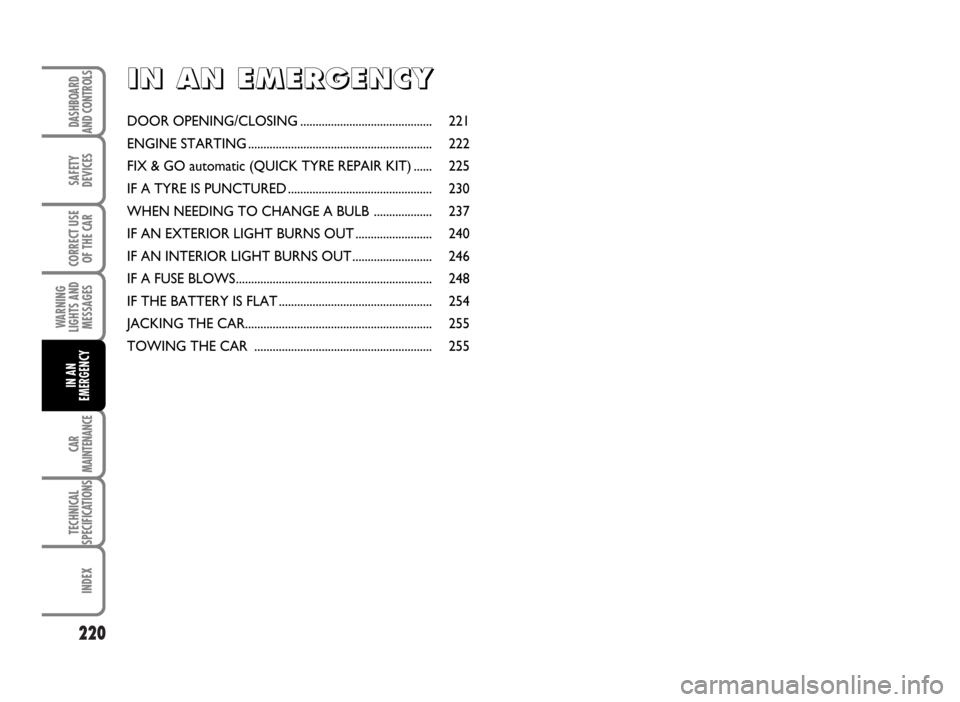
220
SAFETY
DEVICES
CORRECT USE
OF THE CAR
WARNING
LIGHTS AND
MESSAGES
CAR
MAINTENANCE
TECHNICAL
SPECIFICATIONS
INDEX
DASHBOARD
AND CONTROLS
IN AN
EMERGENCY
I I
N N
A A
N N
E E
M M
E E
R R
G G
E E
N N
C C
Y Y
DOOR OPENING/CLOSING ........................................... 221
ENGINE STARTING ............................................................ 222
FIX & GO automatic (QUICK TYRE REPAIR KIT) ...... 225
IF A TYRE IS PUNCTURED ............................................... 230
WHEN NEEDING TO CHANGE A BULB ................... 237
IF AN EXTERIOR LIGHT BURNS OUT ......................... 240
IF AN INTERIOR LIGHT BURNS OUT .......................... 246
IF A FUSE BLOWS................................................................ 248
IF THE BATTERY IS FLAT .................................................. 254
JACKING THE CAR............................................................. 255
TOWING THE CAR .......................................................... 255
Page 222 of 314
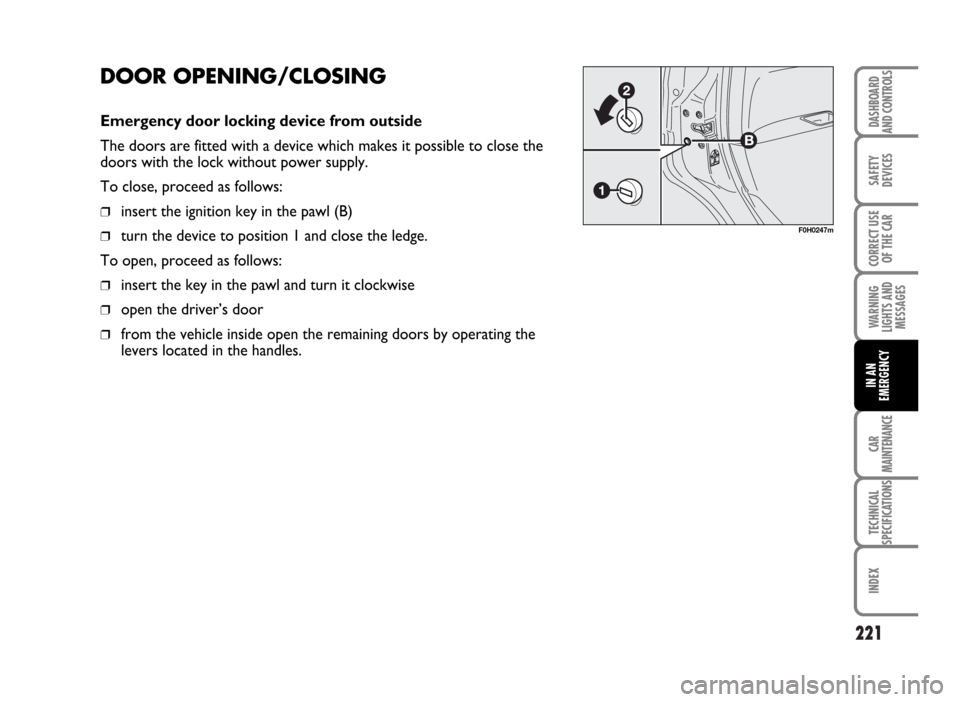
221
SAFETY
DEVICES
CORRECT USE
OF THE CAR
WARNING
LIGHTS AND
MESSAGES
CAR
MAINTENANCE
TECHNICAL
SPECIFICATIONS
INDEX
DASHBOARD
AND CONTROLS
IN AN
EMERGENCY
DOOR OPENING/CLOSING
Emergency door locking device from outside
The doors are fitted with a device which makes it possible to close the
doors with the lock without power supply.
To close, proceed as follows:
❒insert the ignition key in the pawl (B)
❒turn the device to position 1 and close the ledge.
To open, proceed as follows:
❒insert the key in the pawl and turn it clockwise
❒open the driver’s door
❒from the vehicle inside open the remaining doors by operating the
levers located in the handles.
F0H0247m
Page 223 of 314
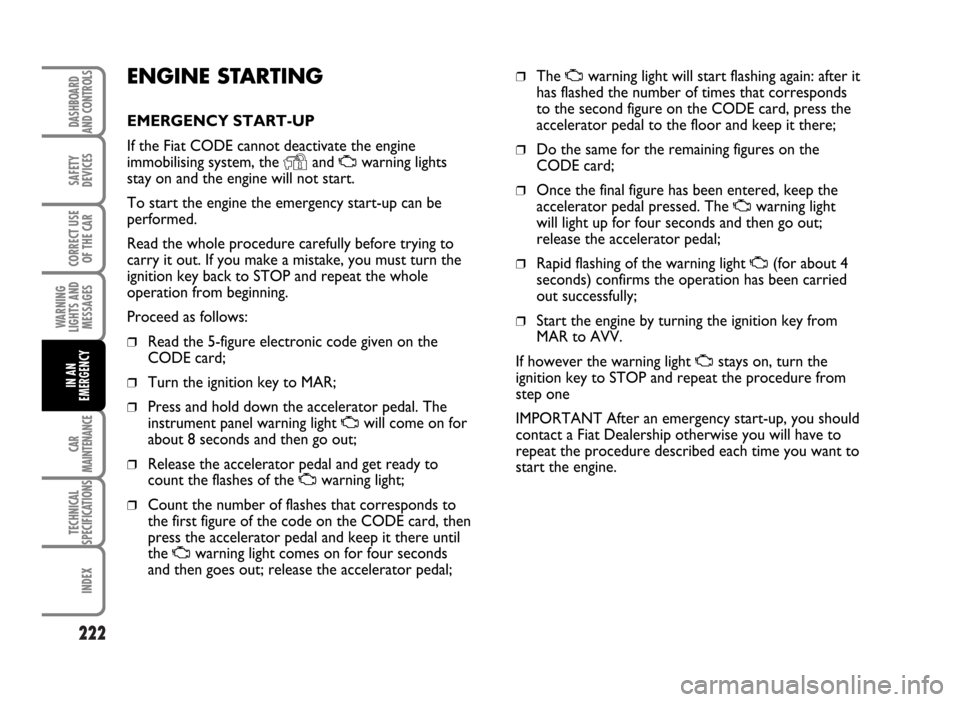
222
SAFETY
DEVICES
CORRECT USE
OF THE CAR
WARNING
LIGHTS AND
MESSAGES
CAR
MAINTENANCE
TECHNICAL
SPECIFICATIONS
INDEX
DASHBOARD
AND CONTROLS
IN AN
EMERGENCY
ENGINE STARTING
EMERGENCY START-UP
If the Fiat CODE cannot deactivate the engine
immobilising system, the
Yand Uwarning lights
stay on and the engine will not start.
To start the engine the emergency start-up can be
performed.
Read the whole procedure carefully before trying to
carry it out. If you make a mistake, you must turn the
ignition key back to STOP and repeat the whole
operation from beginning.
Proceed as follows:
❒Read the 5-figure electronic code given on the
CODE card;
❒Turn the ignition key to MAR;
❒Press and hold down the accelerator pedal. The
instrument panel warning light
Uwill come on for
about 8 seconds and then go out;
❒Release the accelerator pedal and get ready to
count the flashes of the
Uwarning light;
❒Count the number of flashes that corresponds to
the first figure of the code on the CODE card, then
press the accelerator pedal and keep it there until
the
Uwarning light comes on for four seconds
and then goes out; release the accelerator pedal;
❒The Uwarning light will start flashing again: after it
has flashed the number of times that corresponds
to the second figure on the CODE card, press the
accelerator pedal to the floor and keep it there;
❒Do the same for the remaining figures on the
CODE card;
❒Once the final figure has been entered, keep the
accelerator pedal pressed. The
Uwarning light
will light up for four seconds and then go out;
release the accelerator pedal;
❒Rapid flashing of the warning light U(for about 4
seconds) confirms the operation has been carried
out successfully;
❒Start the engine by turning the ignition key from
MAR to AVV.
If however the warning light
Ustays on, turn the
ignition key to STOP and repeat the procedure from
step one
IMPORTANT After an emergency start-up, you should
contact a Fiat Dealership otherwise you will have to
repeat the procedure described each time you want to
start the engine.
Page 224 of 314
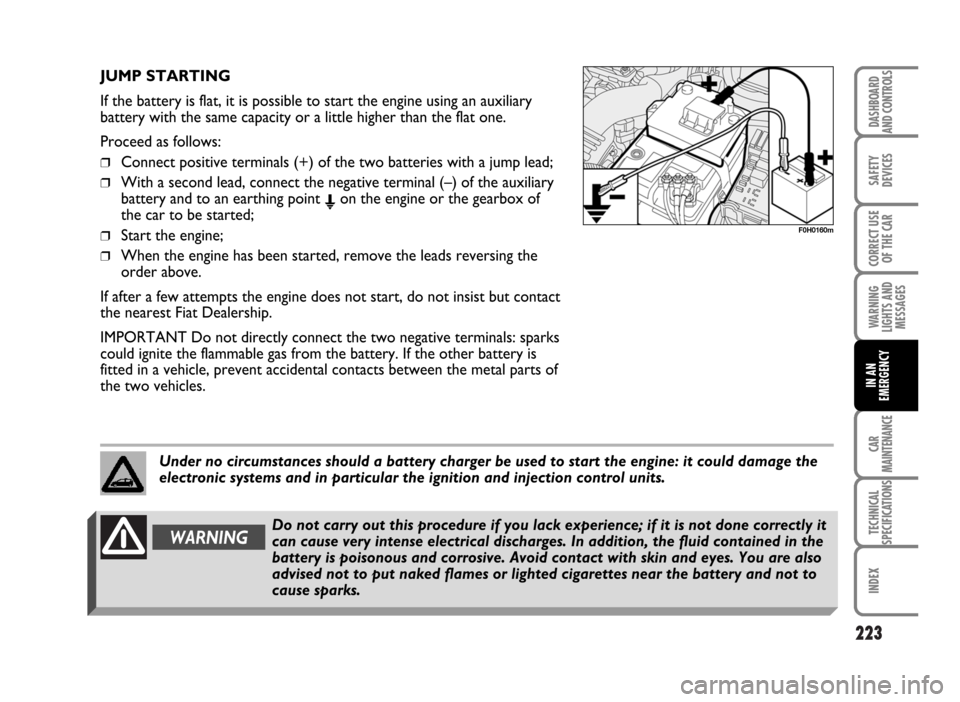
223
SAFETY
DEVICES
CORRECT USE
OF THE CAR
WARNING
LIGHTS AND
MESSAGES
CAR
MAINTENANCE
TECHNICAL
SPECIFICATIONS
INDEX
DASHBOARD
AND CONTROLS
IN AN
EMERGENCY
F0H0160m
JUMP STARTING
If the battery is flat, it is possible to start the engine using an auxiliary
battery with the same capacity or a little higher than the flat one.
Proceed as follows:
❒Connect positive terminals (+) of the two batteries with a jump lead;
❒With a second lead, connect the negative terminal (–) of the auxiliary
battery and to an earthing point Eon the engine or the gearbox of
the car to be started;
❒Start the engine;
❒When the engine has been started, remove the leads reversing the
order above.
If after a few attempts the engine does not start, do not insist but contact
the nearest Fiat Dealership.
IMPORTANT Do not directly connect the two negative terminals: sparks
could ignite the flammable gas from the battery. If the other battery is
fitted in a vehicle, prevent accidental contacts between the metal parts of
the two vehicles.
Under no circumstances should a battery charger be used to start the engine: it could damage the
electronic systems and in particular the ignition and injection control units.
WARNINGDo not carry out this procedure if you lack experience; if it is not done correctly it
can cause very intense electrical discharges. In addition, the fluid contained in the
battery is poisonous and corrosive. Avoid contact with skin and eyes. You are also
advised not to put naked flames or lighted cigarettes near the battery and not to
cause sparks.
Page 225 of 314
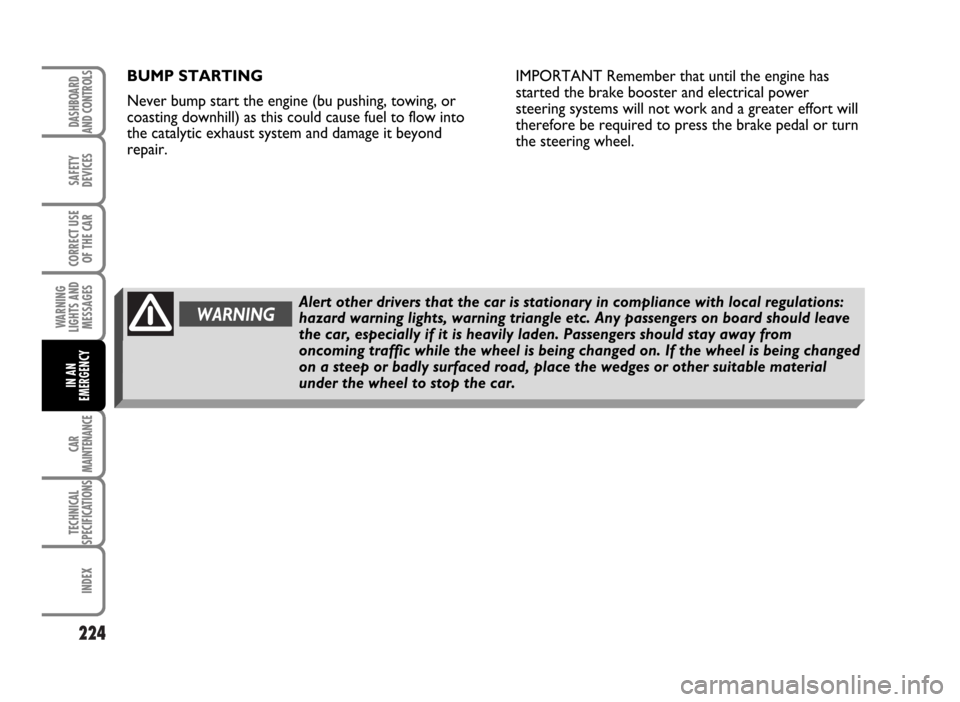
224
SAFETY
DEVICES
CORRECT USE
OF THE CAR
WARNING
LIGHTS AND
MESSAGES
CAR
MAINTENANCE
TECHNICAL
SPECIFICATIONS
INDEX
DASHBOARD
AND CONTROLS
IN AN
EMERGENCY
BUMP STARTING
Never bump start the engine (bu pushing, towing, or
coasting downhill) as this could cause fuel to flow into
the catalytic exhaust system and damage it beyond
repair.IMPORTANT Remember that until the engine has
started the brake booster and electrical power
steering systems will not work and a greater effort will
therefore be required to press the brake pedal or turn
the steering wheel.
WARNINGAlert other drivers that the car is stationary in compliance with local regulations:
hazard warning lights, warning triangle etc. Any passengers on board should leave
the car, especially if it is heavily laden. Passengers should stay away from
oncoming traffic while the wheel is being changed on. If the wheel is being changed
on a steep or badly surfaced road, place the wedges or other suitable material
under the wheel to stop the car.
Page 226 of 314
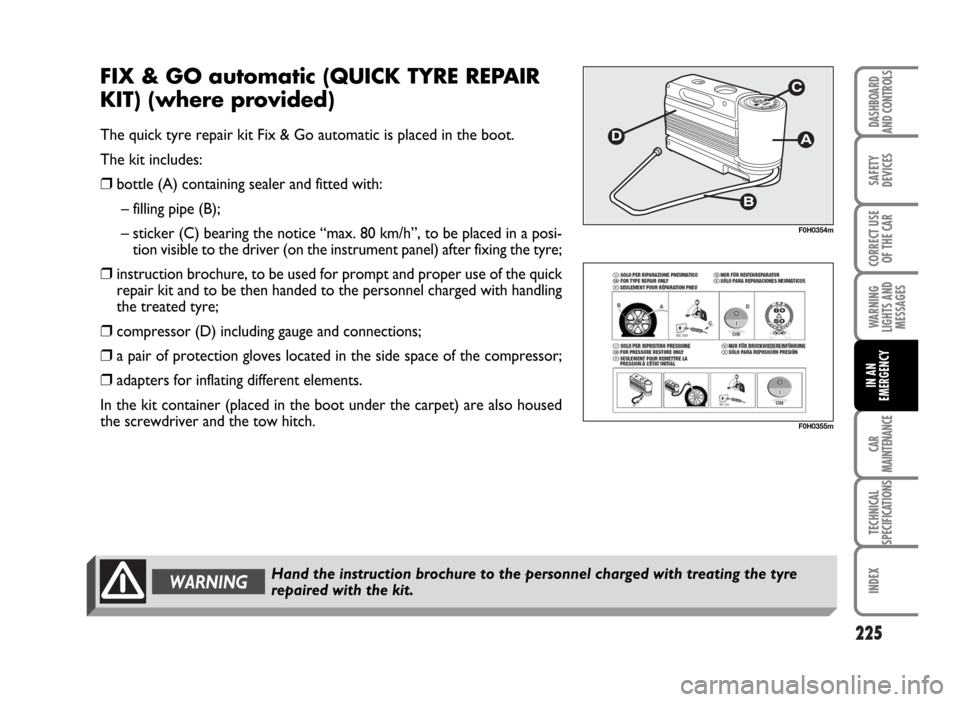
225
SAFETY
DEVICES
CORRECT USE
OF THE CAR
WARNING
LIGHTS AND
MESSAGES
CAR
MAINTENANCE
TECHNICAL
SPECIFICATIONS
INDEX
DASHBOARD
AND CONTROLS
IN AN
EMERGENCY
FIX & GO automatic (QUICK TYRE REPAIR
KIT) (where provided)
The quick tyre repair kit Fix & Go automatic is placed in the boot.
The kit includes:
❒bottle (A) containing sealer and fitted with:
– filling pipe (B);
– sticker (C) bearing the notice “max. 80 km/h”, to be placed in a posi-
tion visible to the driver (on the instrument panel) after fixing the tyre;
❒instruction brochure, to be used for prompt and proper use of the quick
repair kit and to be then handed to the personnel charged with handling
the treated tyre;
❒compressor (D) including gauge and connections;
❒a pair of protection gloves located in the side space of the compressor;
❒adapters for inflating different elements.
In the kit container (placed in the boot under the carpet) are also housed
the screwdriver and the tow hitch.
F0H0354m
F0H0355m
Hand the instruction brochure to the personnel charged with treating the tyre
repaired with the kit.WARNING
Page 227 of 314
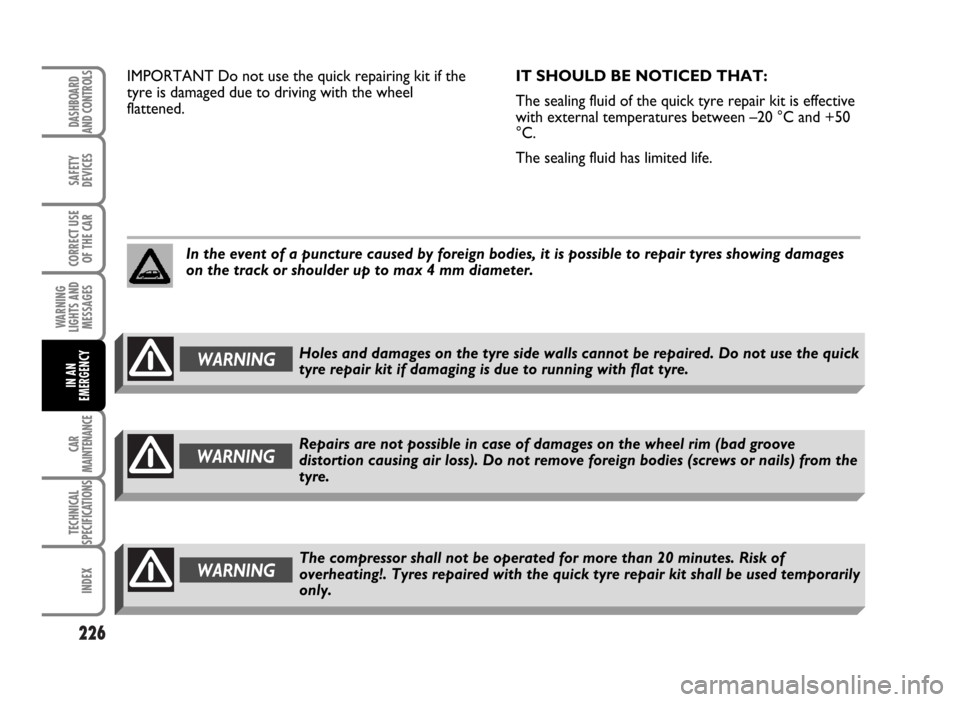
226
SAFETY
DEVICES
CORRECT USE
OF THE CAR
WARNING
LIGHTS AND
MESSAGES
CAR
MAINTENANCE
TECHNICAL
SPECIFICATIONS
INDEX
DASHBOARD
AND CONTROLS
IN AN
EMERGENCY
IMPORTANT Do not use the quick repairing kit if the
tyre is damaged due to driving with the wheel
flattened.IT SHOULD BE NOTICED THAT:
The sealing fluid of the quick tyre repair kit is effective
with external temperatures between –20 °C and +50
°C.
The sealing fluid has limited life.
WARNINGHoles and damages on the tyre side walls cannot be repaired. Do not use the quick
tyre repair kit if damaging is due to running with flat tyre. In the event of a puncture caused by foreign bodies, it is possible to repair tyres showing damages
on the track or shoulder up to max 4 mm diameter.
Repairs are not possible in case of damages on the wheel rim (bad groove
distortion causing air loss). Do not remove foreign bodies (screws or nails) from the
tyre.WARNING
The compressor shall not be operated for more than 20 minutes. Risk of
overheating!. Tyres repaired with the quick tyre repair kit shall be used temporarily
only.WARNING
Page 228 of 314
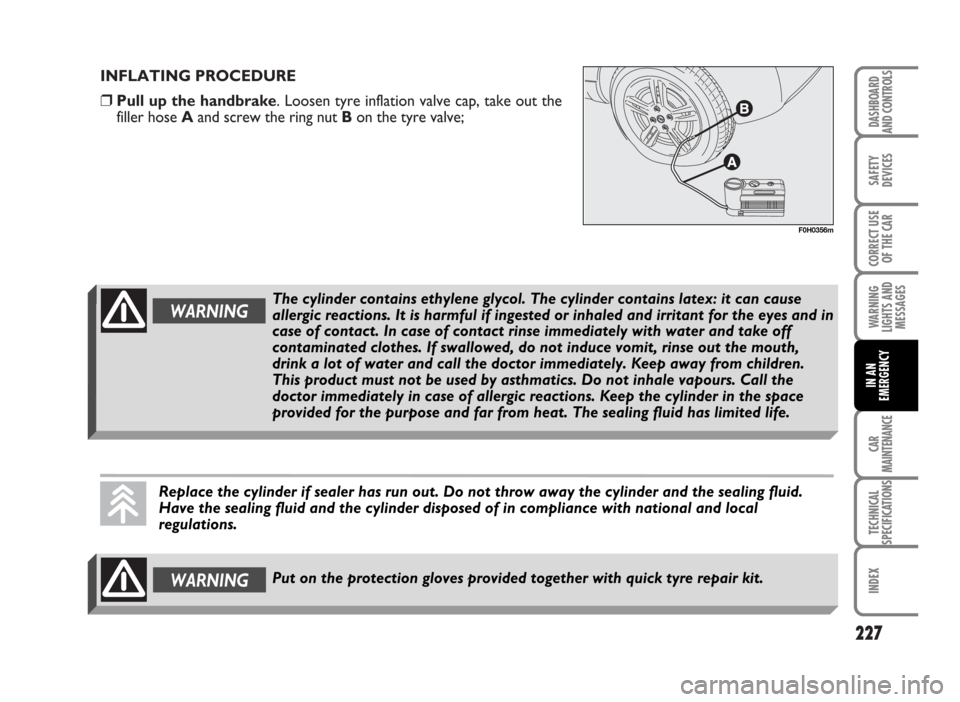
INFLATING PROCEDURE
❒Pull up the handbrake. Loosen tyre inflation valve cap, take out the
filler hose Aand screw the ring nut Bon the tyre valve;
227
SAFETY
DEVICES
CORRECT USE
OF THE CAR
WARNING
LIGHTS AND
MESSAGES
CAR
MAINTENANCE
TECHNICAL
SPECIFICATIONS
INDEX
DASHBOARD
AND CONTROLS
IN AN
EMERGENCY
F0H0356m
Replace the cylinder if sealer has run out. Do not throw away the cylinder and the sealing fluid.
Have the sealing fluid and the cylinder disposed of in compliance with national and local
regulations.
Put on the protection gloves provided together with quick tyre repair kit.WARNING
WARNINGThe cylinder contains ethylene glycol. The cylinder contains latex: it can cause
allergic reactions. It is harmful if ingested or inhaled and irritant for the eyes and in
case of contact. In case of contact rinse immediately with water and take off
contaminated clothes. If swallowed, do not induce vomit, rinse out the mouth,
drink a lot of water and call the doctor immediately. Keep away from children.
This product must not be used by asthmatics. Do not inhale vapours. Call the
doctor immediately in case of allergic reactions. Keep the cylinder in the space
provided for the purpose and far from heat. The sealing fluid has limited life.
Page 229 of 314
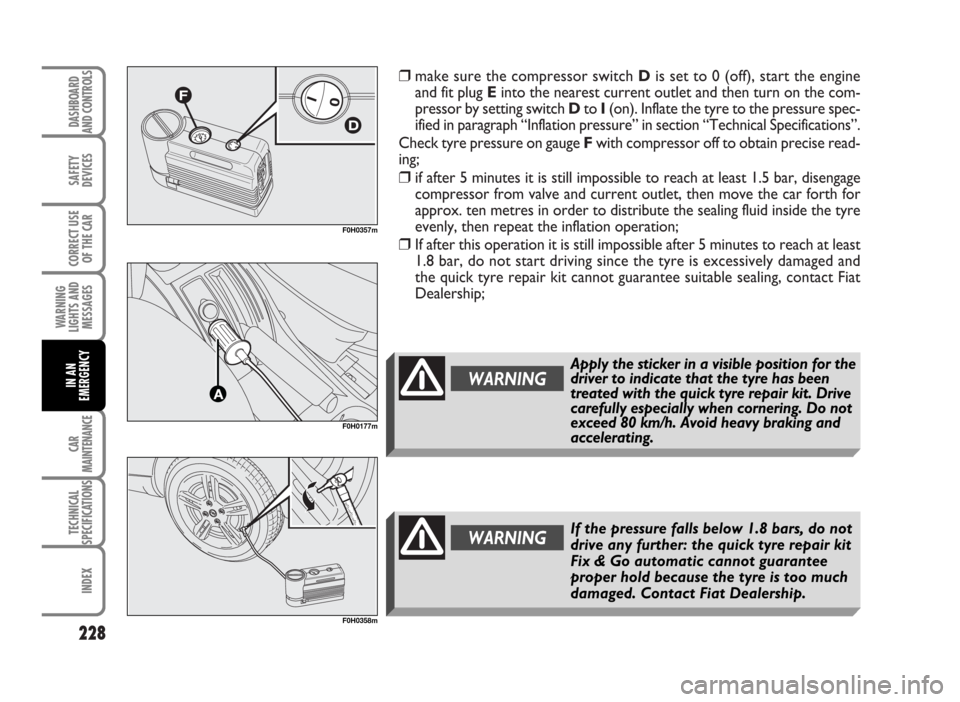
❒make sure the compressor switch Dis set to 0 (off), start the engine
and fit plug Einto the nearest current outlet and then turn on the com-
pressor by setting switch D to I(on). Inflate the tyre to the pressure spec-
ified in paragraph “Inflation pressure” in section “Technical Specifications”.
Check tyre pressure on gauge Fwith compressor off to obtain precise read-
ing;
❒if after 5 minutes it is still impossible to reach at least 1.5 bar, disengage
compressor from valve and current outlet, then move the car forth for
approx. ten metres in order to distribute the sealing fluid inside the tyre
evenly, then repeat the inflation operation;
❒If after this operation it is still impossible after 5 minutes to reach at least
1.8 bar, do not start driving since the tyre is excessively damaged and
the quick tyre repair kit cannot guarantee suitable sealing, contact Fiat
Dealership;
228
SAFETY
DEVICES
CORRECT USE
OF THE CAR
WARNING
LIGHTS AND
MESSAGES
CAR
MAINTENANCE
TECHNICAL
SPECIFICATIONS
INDEX
DASHBOARD
AND CONTROLS
IN AN
EMERGENCY
F0H0357m
F0H0177m
F0H0358m
WARNINGIf the pressure falls below 1.8 bars, do not
drive any further: the quick tyre repair kit
Fix & Go automatic cannot guarantee
proper hold because the tyre is too much
damaged. Contact Fiat Dealership.
WARNING
Apply the sticker in a visible position for the
driver to indicate that the tyre has been
treated with the quick tyre repair kit. Drive
carefully especially when cornering. Do not
exceed 80 km/h. Avoid heavy braking and
accelerating.
Page 230 of 314
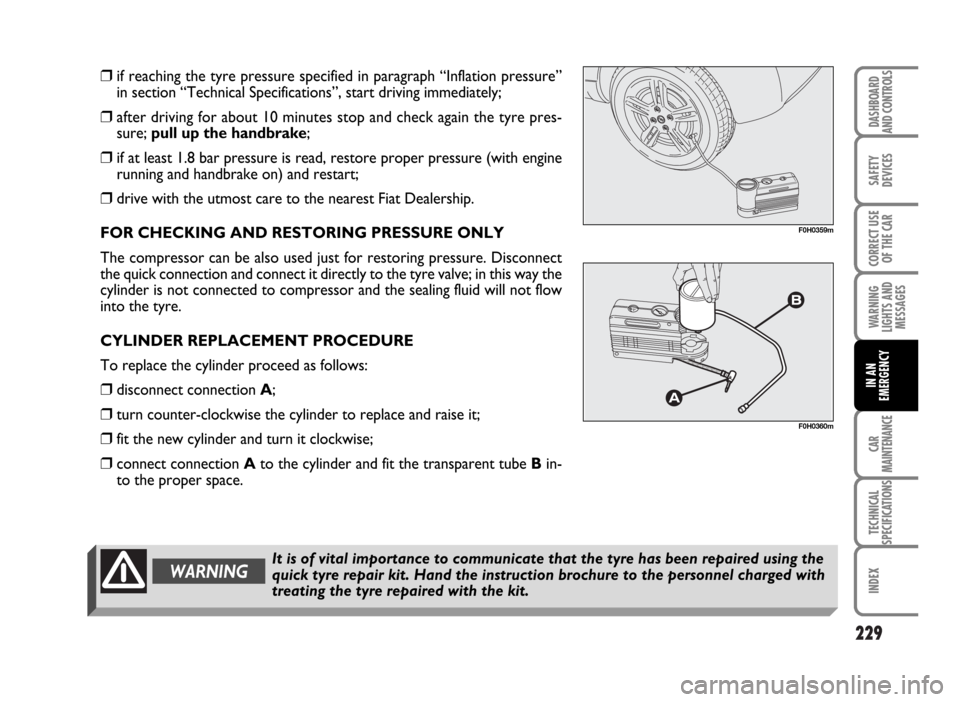
229
SAFETY
DEVICES
CORRECT USE
OF THE CAR
WARNING
LIGHTS AND
MESSAGES
CAR
MAINTENANCE
TECHNICAL
SPECIFICATIONS
INDEX
DASHBOARD
AND CONTROLS
IN AN
EMERGENCY
It is of vital importance to communicate that the tyre has been repaired using the
quick tyre repair kit. Hand the instruction brochure to the personnel charged with
treating the tyre repaired with the kit.WARNING
❒if reaching the tyre pressure specified in paragraph “Inflation pressure”
in section “Technical Specifications”, start driving immediately;
❒after driving for about 10 minutes stop and check again the tyre pres-
sure; pull up the handbrake;
❒if at least 1.8 bar pressure is read, restore proper pressure (with engine
running and handbrake on) and restart;
❒drive with the utmost care to the nearest Fiat Dealership.
FOR CHECKING AND RESTORING PRESSURE ONLY
The compressor can be also used just for restoring pressure. Disconnect
the quick connection and connect it directly to the tyre valve; in this way the
cylinder is not connected to compressor and the sealing fluid will not flow
into the tyre.
CYLINDER REPLACEMENT PROCEDURE
To replace the cylinder proceed as follows:
❒disconnect connection A;
❒turn counter-clockwise the cylinder to replace and raise it;
❒fit the new cylinder and turn it clockwise;
❒connect connection Ato the cylinder and fit the transparent tube Bin-
to the proper space.
F0H0359m
F0H0360m